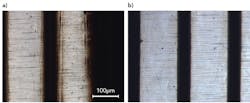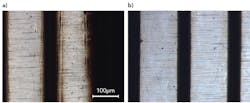Femtosecond lasers enable quality microfabrication
Laser technology applies to several material types
MARTYNAS BARKAUSKAS, VYTAUTAS BUTKUS, and SIMAS BUTKUS
Lasers are indispensable tools in many areas of industry, science, and medicine. Now, ultrafast laser-based micromachining is a widespread example of laser source utilization, leading to unprecedented microfabrication quality.
Advantages of femtosecond laser processing over regular mechanical and laser techniques in automotive, medical instrumentation, and electronics industries include (but are not limited to) high speed, precision, quality, and reproducibility, allowing for simplified or, in many cases, no post-processing operations. This field of laser technology is currently under intensive development and many exciting micromachining techniques are yet to emerge.
In laser-assisted manufacturing, every processed material is a special case and some research is always required. Laser parameters, such as pulse length, wavelength, repetition rate, and energy, might determine the processing rate and quality. Therefore, finding that optimal set of laser parameters and choosing the right cost-effective technology is very important. At this point, a highly versatile industrial laser with tunable pulse length, energy, and repetition rate becomes a vital part of the whole system.
Femtosecond ablation
In one way or another, the desired mechanical modifications in bulk material or a surface are the results of related physical phenomena, occurring right after deposition of light energy to a material. In the simplest terms, these processes can be divided into "hot" and "cold" micromachining.
In hot micromachining, solid phase material at the optical pulse-material interaction zone is transformed into the gas phase from local heating, leading to vaporization and ejection of material. Local heating is achieved because of the electron-phonon interaction of the excited free electrons and the material crystal lattice.
In hot ablation (i.e., material removal), laser pulse length and material removal rate is comparable to the timescales of material thermal diffusion. As a result, heat is transferred outside the ablation zone and might cause collateral thermal damage commonly referred to as heat-affected zone (HAZ). Moreover, the hot-ablation threshold is very dependent on the number of material defects and impurities in the ablation zone, leading to less-precise and less-reproducible micromachining results. Together, HAZ and ablation variability impede success of some applications.
Detrimental effects because of HAZ and material impurities are, in theory, completely absent in the working conditions of cold ablation, offered by femtosecond laser pulses through a nonlinear absorption process. Since the peak energy of femtosecond pulses is much higher than picosecond or nanosecond pulses, electrons in the valence band are excited to a great extent, resulting in local material ionization. Enormous electrostatic forces between the ions are established, and the material goes through irreversible changes as it is locally exploded or cracks are formed. As the process is faster than thermalization time, locally induced heat, if any, is effectively stripped away along with the removed material.
Femtosecond lasers may also offer faster micromachining. For example, measured cutting rate dependence on laser pulse length and energy is shown for a nickel-iron alloy (Invar; FIGURE 1). There, cutting rate increases when shorter pulses are used, and the gain in the rate is at least 50% when femtosecond instead of picosecond pulses are used. Apart from faster cutting, the edge quality at the cut is much better for the femtosecond cuts (FIGURE 2).
Processing with femtosecond high-peak-power pulses might rarely lead to nonlinear effect-induced plasma formation at the material surface or even in ambient air. Such effects might impair material processing quality, but it is always possible to mitigate these effects with a versatile laser source, offering fine tunability of its output radiation properties, such as pulse duration and repetition rate.
Additional laser processing uses
Cutting. For heat-sensitive or brittle material cutting, HAZ must be minimized. Therefore, femtosecond laser machining quite often becomes a key enabling technique for high-quality cutting.
Femtosecond laser machining allows a user to obtain smooth and burr-free cuts in most materials, such as metals, ceramics, glasses, polymers, and organic tissues, while at the same time keeping the surface free of debris, thus requiring less or even no post-processing. These properties are crucial in many applications, such as in micromachining of medical implants made of delicate materials.
Kerfs and struts measuring a few microns wide are cut in the microfabrication of cylindrical stents of heart valve frames. In the case of Nitinol-based medical micro-implants, the advantages of using femtosecond pulses over picosecond pulses were proven obvious, resulting in higher precision, overall process robustness, and production yield. Moreover, apart from cutting, the same femtosecond laser source can be used for micromachining of the material surface, showing great promise when being applied in manufacturing of medical microstructures composed of different geometries.
Etching. Femtosecond laser pulses can be applied in the creation of structural and optical changes within the bulk of transparent materials, and for subsequent chemical etching processes. This femtosecond laser irradiation and chemical etching method is used in fused silica substrates for the creation of microfluidic applications (lab-on-chip, μTAS, etc.) and microchip 3D stacking.
Because femtosecond pulses create precise modifications without collateral damage at high processing rates, the second part—chemical etching—is comparably a very slow process that might take hours to complete. However, novel hybrid chemical etching technologies, employing a combination of different chemical agents, show great promise in this field. What's more, the chemical etching step is effortlessly parallelized, as multiple samples can be etched at the same time in the same container.
Drilling. Many industrial applications require drilling of high-quality and controllable-geometry holes in materials, such as fuel or ink-jet injection nozzles. To achieve high processing speed and quality, high pulse fluencies are necessary for a few reasons. First, the ejected particles from deep within a small hole need to have high kinetic energy to be able to escape from the drilled hole. Secondly, as the hole becomes deeper, effective fluence tends to decrease from laser-drilled holes being of conical shape.
In femtosecond laser hole drilling, shaping of the hole is usually performed in another stage, separated from the high-fluence perforation. Such laser post-processing allows for additional adjustment, as some applications might require cylindrical holes, whereas others might require tapered ones.
New processing techniques like helical drilling have been developed to further increase processing quality. In general, femtosecond laser machining has excellent prospects for the production of mentioned fluidic components or other dosing devices.
Surface structuring. Femtosecond laser pulses are beneficial in advanced material surface structuring (FIGURE 3). Microfabrication of surface nanostructures—such as grooves, spikes, and dimples—using femtosecond pulses is both precise and robust, and can be applied to large areas. Such nanostructures can, for example, change the surface's wetting behavior and find applications in plasmonics, nanophotonics, nanoelectronics, solar cells fabrication, etc.
Applications in UV
Ultraviolet (UV) femtosecond pulses are used when micrometer-size parts must be fabricated from materials that are extremely sensitive to heat effect. Applications include processing of different types of piezo ceramics and sophisticated crystal materials for infrared detection, among others. In these cases, third and fourth harmonics of ytterbium-based femtosecond lasers (343 and 257nm) have been used.
Although UV femtosecond pulses are very attractive for a variety of scientific and industrial applications, proper design of optics for delivering UV femtosecond pulses remains challenging. However, industrial-grade UV femtosecond lasers are currently available on the market and offer reliable operation for thousands of hours.
Another proven application of UV femtosecond pulses is laser-ablation inductively coupled plasma mass spectrometry. Femtosecond ultraviolet pulses are preferred to ensure absorption of most solid-phase materials.
In laser-assisted mass spectrometry, the process consists of two stages: ablation and detection. After particles from the sample are locally ionized because of the high-energy light interaction with material, they are passed to the mass spectrometer for identification. By this means, spatially resolved analysis with micrometer resolution is possible in complex samples, such as melt inclusions, dust aerosols, zonations of minerals, ultrathin films, and biological samples.
Apart from the above-mentioned advantages, femtosecond laser pulses were also shown to reduce the matrix effect and elemental fractionation, which might negatively influence the quality of analysis.
Femtosecond laser-assisted mass spectrometry systems are already commercially available, and the technique itself has considerable potential to be routinely used for in situ analysis of element and isotopic compositions for a wide variety of materials.
Outlook
These are exciting times for femtosecond laser applications in high-quality material processing, with many new applications emerging daily. High efficiency, elimination of HAZ, and applicability to many different materials are the key driving factors in this field.
On the laser source side, this drives additional parameter flexibility requirements, permitting the user to fine-tune the light-matter interaction recipe for the highest efficiency and quality.
REFERENCES
1. H. Misawa and S. Juodkazis, 3D Laser Microfabrication: Principles and Applications, Wiley-VCH Verlag, Weinheim, Germany (2006).
2. K. Sugioka and Y. Cheng, Light Sci. Appl., 3, e149 (2014).
3. R. Schaeffer, Fundamentals of Laser Micromachining, CRC Press, Boca Raton, FL (2012).
Dr. MARTYNAS BARKAUSKAS([email protected]) and Dr. VYTAUTAS BUTKUS are both with Light Conversion, Vilnius, Lithuania (http://lightcon.com), while SIMAS BUTKUS is with the Faculty of Physics at Vilnius University, Vilnius, Lithuania.



